For those seeking to add a touch of nature’s resilience and beauty to their indoor spaces, cacti offer an ideal solution.
This guide provides an overview of various indoor cactus types, each with its unique charm and minimal care requirements.
Cacti are not only a great way to enhance the aesthetics of a room but also thrive with little attention, making them perfect for busy or forgetful plant owners.
From the adorable Bunny Pear Cactus to the striking Old Lady Cactus, this collection presents a range of options for different preferences and settings.
Accompanied by vivid descriptions and indoor cactus types with pictures, this guide will help you choose the perfect cactus to bring life and a touch of the desert into your home or office.
The Best Range in Different Kinds of Cactus That You Can Keep Indoors Are:
Bunny Pear Cactus
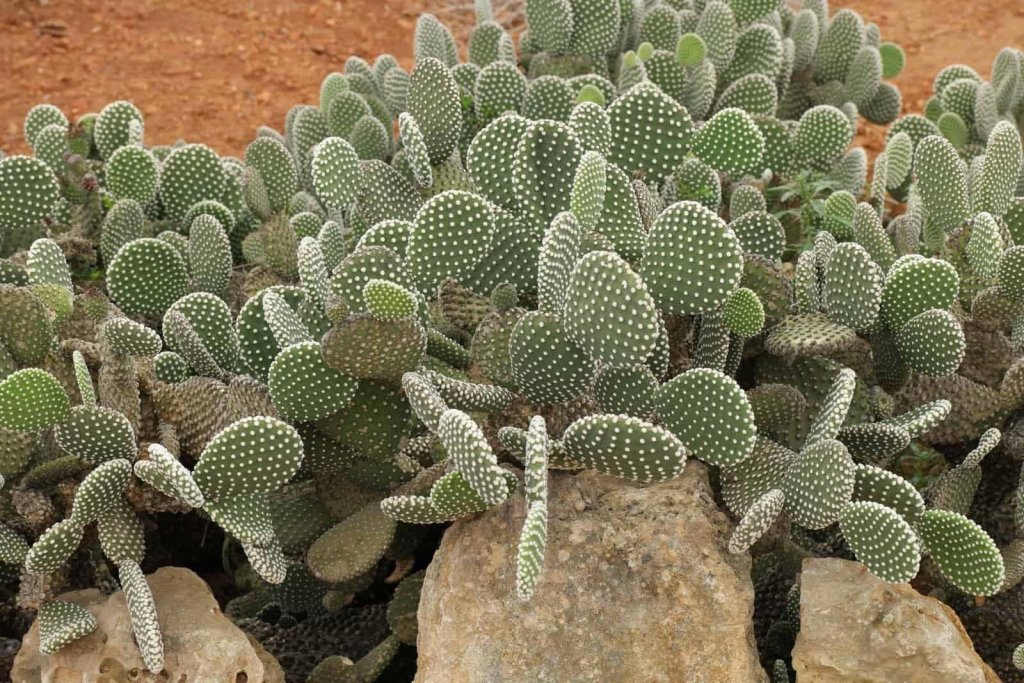
These low-maintenance cacti are trendy in different households because they have cute pads shaped like rabbit ears.
These cacti are a brilliant option for becoming outdoors in gardens, rock gardens, xeriscape gardens, or Mediterranean gardens.
People prefer to keep their Bunny cacti indoors, planted on their beautiful balconies.
Gratitude to their bunny pads, they can bear even more extended times of aridity than other succulents and cacti.
Even if you put them indoors or outdoors growing, they need daily vulnerability below the full sun.
Bunny Ears plant cannot tolerate humidity conditions indoors as well outdoors.
They do not own a proper body for nursery or conservatoire growing. Their herbs and fruits are non-toxic to people and pets.
It will improve if you put these cacti in place beyond children’s range and prying animals.
Bunny Ears plants relate to the Opuntia genus that includes about 150-180 varieties of flat cacti.
The Opuntia genus is also related to as “Prickly Pear” and is the standard general cacti species in the United States.
Old Lady Cactus
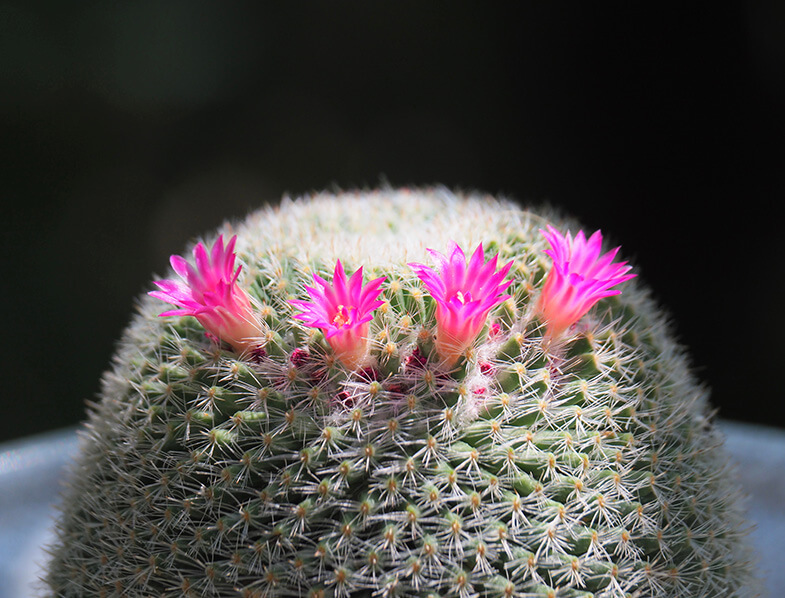
Plants use their hair to keep them warm, calm and protected. Plants use hair to collect food, dispense seeds; insect-eating pitcher plants even have down-turned hairs to hold the insect from hiding.
The hair is a survival strategy adopted by many cacti. Old man, lady, and other cacti have the addition of a hairy layer called a “momentum.”
The tomentum helps them linger fresh in the hot desert sun when the traditional route of cooling used by plants, transpiration, is unavailable.
However, in arid areas, sweltering to cool down is a scrap of valuable water, and so barrens plants keep their stomata shut throughout the day, limiting water loss.
At night, these kinds of the plant start their stomata to bring in carbon dioxide for photosynthesis.
Low humidity is a test; a tomentum can give additional strength from draining out by catching a moist air cover adjacent to the leaf’s surface or track.
This method’s disadvantage is that now this air cover converts close, so it cannot take any more extra water from transpiration.
So, the plant must turn to a different strategy. The answer to quieting down is to get longer hair.
The cactus’ white hair decreases the light images before it can get swallowed and turned into heat.
Just as using white can help keep you fresh in the sun. Getting white hair indicates the cactus can catch lighter.
This local of Mexico prefers well-draining soil and hot temperatures and can be planted outside in hot climes or inside as a houseplant.
Rat Tail Cactus
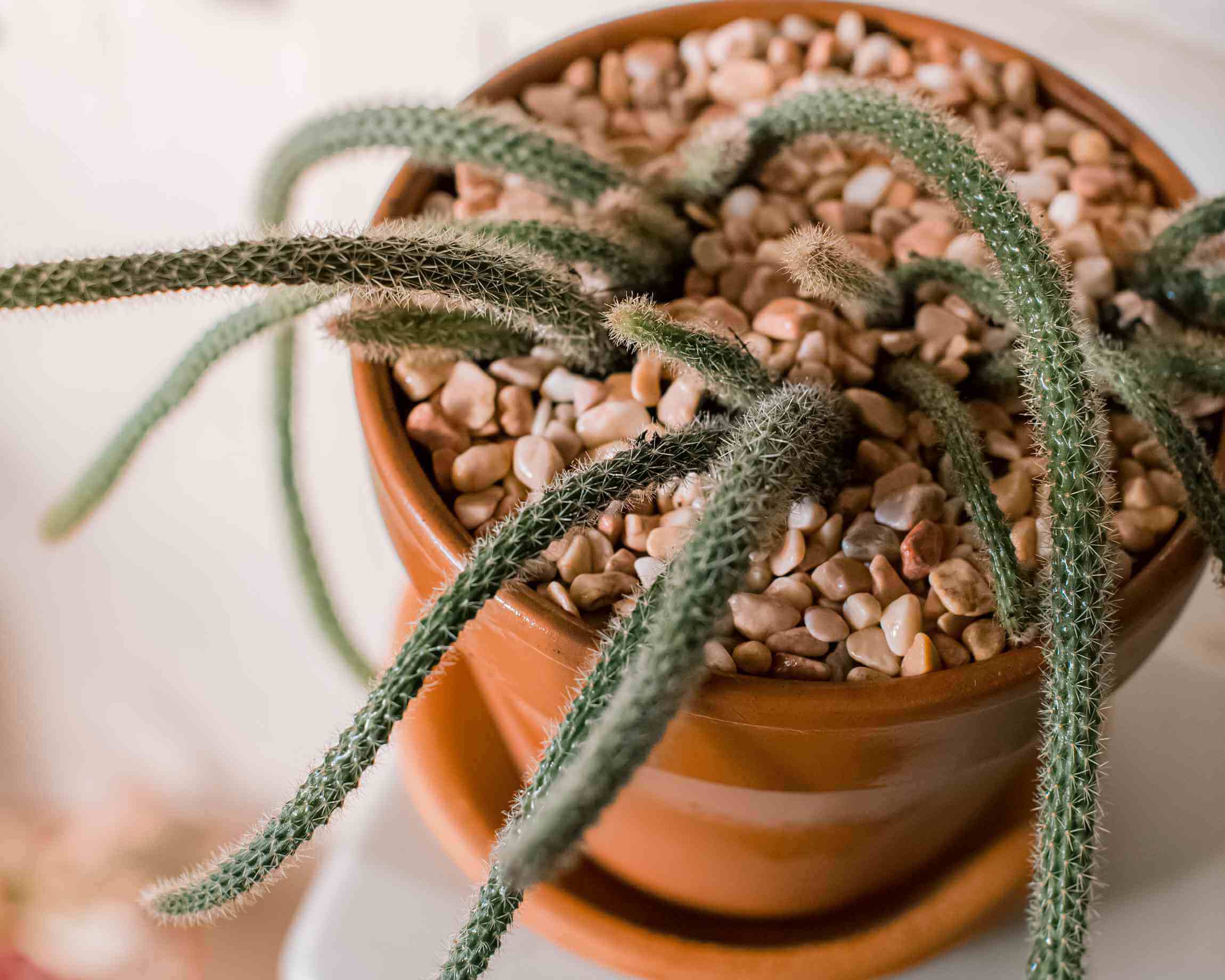
These cacti have a common name (Aporocactus flagelliformis) or (Disocactus flagelliform) is the identity of several slender, attractive outdoor plants that have lengthy, supple branching hanging stems. Bristly “hair” covers the shuffle stems, which can train into many shapes and forms.
Rattail plant cactus is a strangle (or lithophyte).
That means, in the wild, it does not require soil for growth. In its local areas, southern Mexico and Central America, the rat tail cactus is often found clambering over rocks or into trees.
When put as a garden or houseplant, its wandering habits make it perfect for trailing or growing in a hanging basket.
When the rat tail cactus plants grow, it produces numerous, beautiful, tubular flowers in the springtime.
The flowers appear in shades of pink, crimson, and red. The blooming period lasts for several days.
If you put Disocactus flagelliform in a position pot, placed the plant up big so the petioles can recoil.
In springtime, summertime, or fall, these cacti are cheerful at moderate room heat. If you feel the warmness, your cactus will be satisfied.
Temperatures varying from 45° to 50° degrees Fahrenheit are incredibly proper for them. The rat tail can provide temperatures up to 60° degrees Fahrenheit in the winter months.
Barrels Cactus
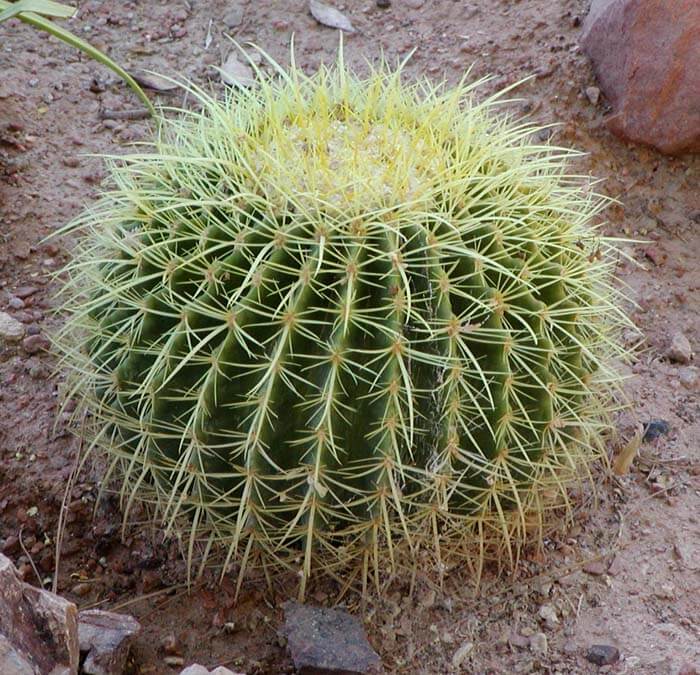
Barrel cactus is the perfect desert-dweller of stories. There are several changes within both the Echinocactus and the Ferocactus.
The Echinocactus one has a hairy crown of fine needles, while The Ferocactus has thorned.
Each one can be built as a houseplant or, in less prominent locations, the dried garden and are beautiful additions to a home display.
Growing barrel cactus required a sunny position and minimum watering.
Potted cactus can be stored in the hottest room of the house in an exact sunny position.
Direct sunlight may hurt the plant in the summer’s apogee, so you should push them back from the glass or turn the slats on your covers to spread the light.
Soil for barrel plants is often sand with little topsoil, perlite, and fertilizer. Prepared cactus mixes are proper for getting barrel cactus.
Unglazed pots are most suitable for potted cactus as they provide the distillation of excess water.
Water is a crucial element for the care of barrel cactus. The plants are essential to parched desert areas and usually have only rain to provide their rain requirements.
Your barrel cactus requires water per week in summer. The barrel plant does not require much water in winter when it is dormant.
Water once mid-December and February. Enough water in the season may make the plant create a substantial yellow flower.
Surprisingly, the plant will then produce delicious fruit.
Christmas Cactus
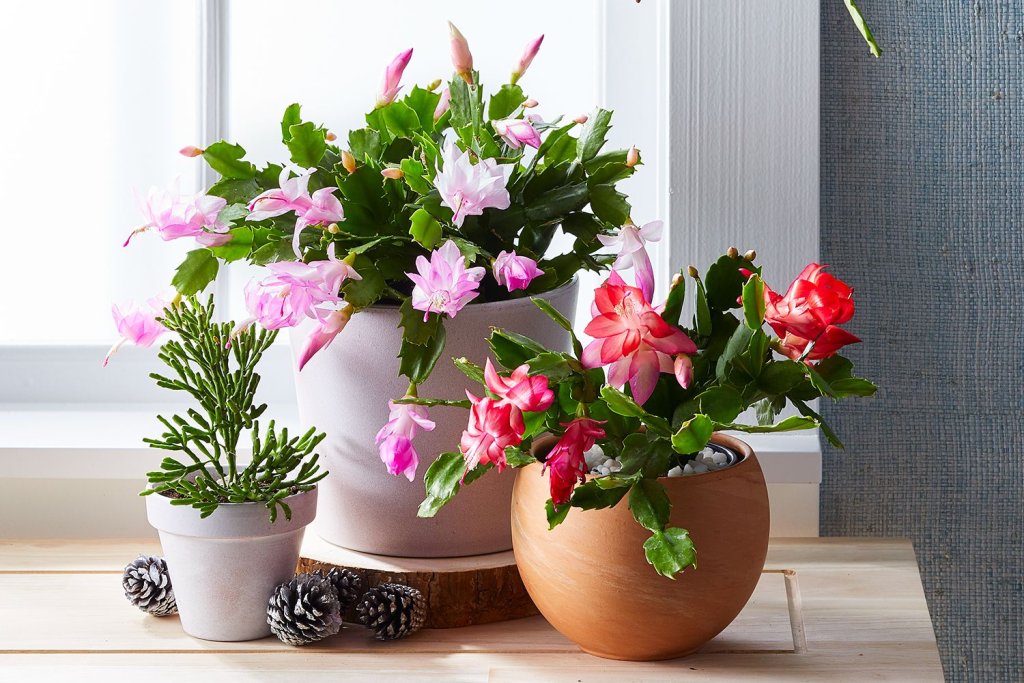
The Christmas cactus (Schlumbergera Bridgesii) blooms for a long time inside with unique beautiful-looking flowers in the flower kingdom.
This cactus is a popular plant, but most significant people are not conscious of its exceptional condition.
Not every cactus is produced in desert environments and needs occasional rare watering.
These plants call the tropical rain forest home and thus need watering when the top portion of the earth in the pot appears exhausted while moving.
Soak the soil until water flows through the pot’s drainage holes, ready for a few minutes, and then get free of any excess water collected in the drip pan under the pool.
A water-soluble compost recommended for flowering houseplants can be used for its active growth but be sure to grasp the fertilizer container’s regulations about the number and frequency of application.
The Christmas cactus prefer wet circumstances, and the houses are often hard.
Spill water over the rocks, but do not let the water rise over the back of the top floor of rocks.
The water will concentrate, raising the moisture on all the surfaces of the plant. Heat and day length allows significant flower triggers for the Christmas plant.
Bishop’s Cap
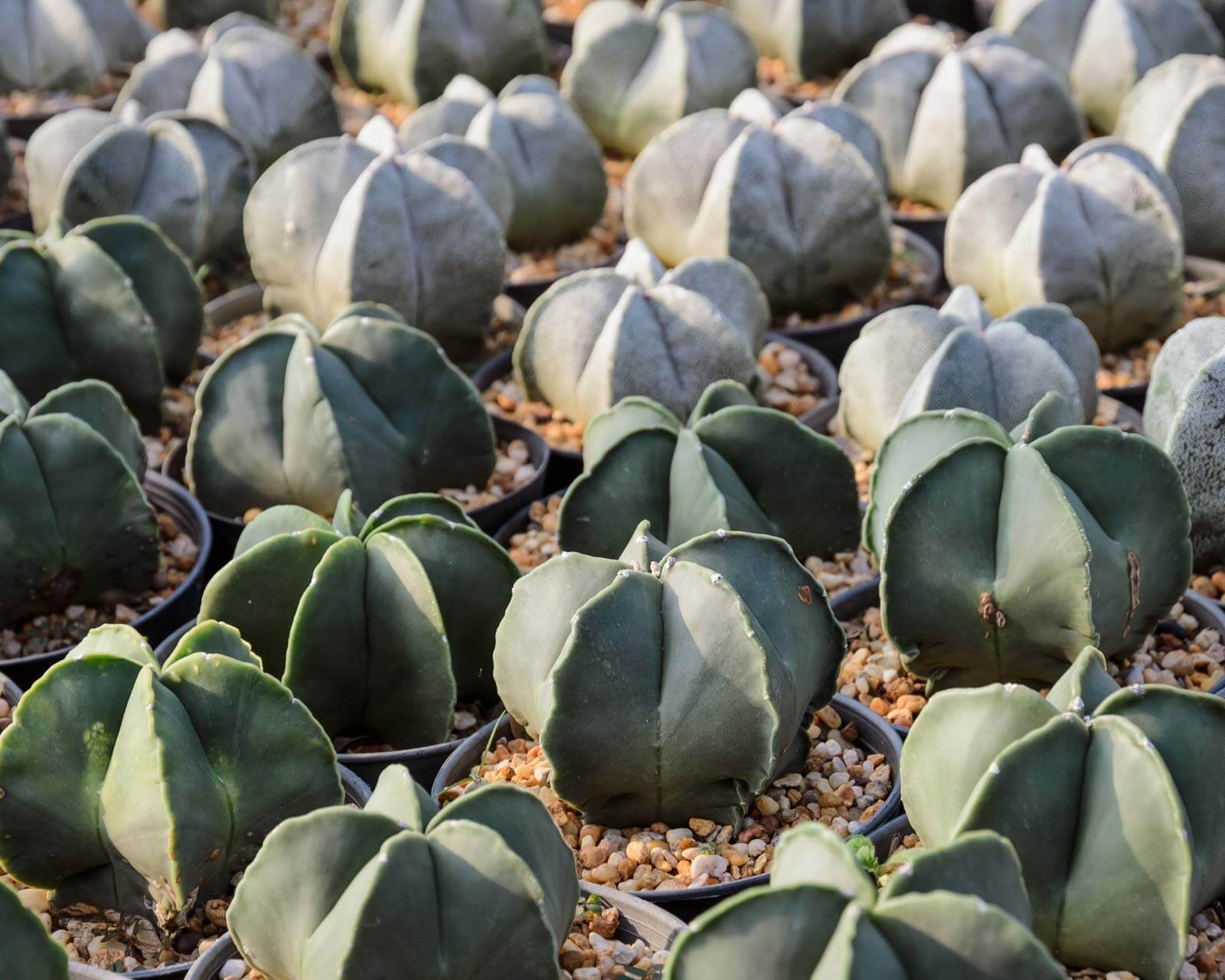
Young Bishop’s cap plants are extra or less bulbous, like a globe. However, as the cactus grows taller white hairy scales look more like a Bishop’s miter, the traditional headdress put on by bishops. Generally, adult Bishop’s Cap plants are star-shaped, with five protruding ribs having white dots or spots.
However, keep in mind that the figure of ribs can vary. The star plant may have only three ribs or, in more rare cases, as many as ten ribs! The stem of a mature Astrophytum Myriostigma can grow up to 23″ – 39″ inches in height and around 8″ inches in diameter.
Bishop’s Cap’s growth rate is slow, and the plant takes its time to grow and produce flowers. However, growing plants cannot touch hard sunlight.
Plants do best in light shade and should nevermore be in full sun. Keep in understanding that these plants need winter rest.
Star Cactus
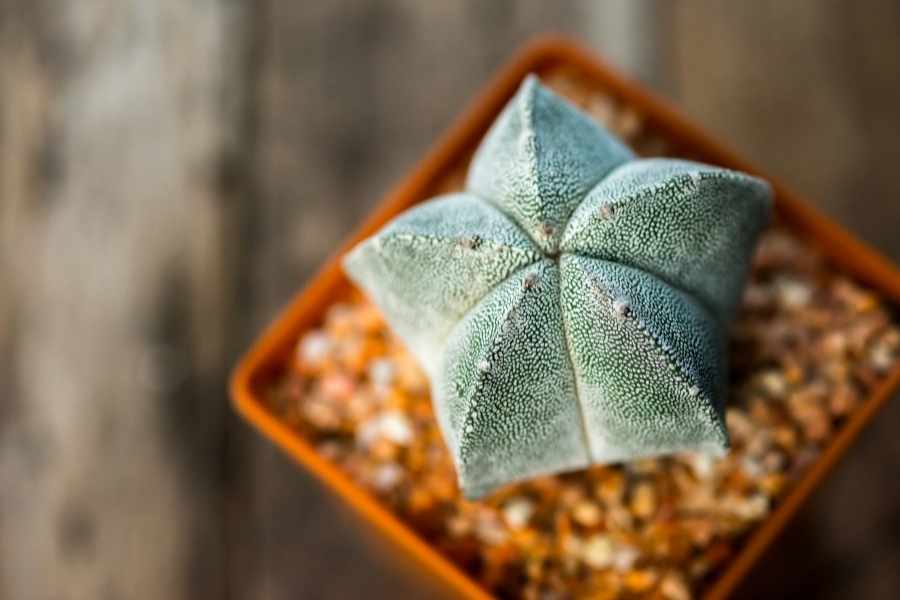
The flower has been excessively collected in its habitation, and the undomestic population is threatened. Get your star cactus plants from a recognized nursery that grows them from seed.
This cactus does perfectly well in a bright window in the home. If you take your hands-on experts, start them in seed flats with a soil composite mix.
Hold the soil wet until germination, then move to a warm location with protection from the noonday sun.
Novice gardeners love the ease of cacti cares as indoor plants. They flourish on neglect, although star cactus plants will need water frequently.
The body will flatten out and turn dark if it is in terrible need of water.
Pot them up in a purchased cactus mix or equal parts potting soil and sand. The box should be free draining and unglazed, so excess moisture evaporates readily.
April is the best time to report, but the plants like to be pot-bound, so this does not need to be done often.
Peanut Cactus
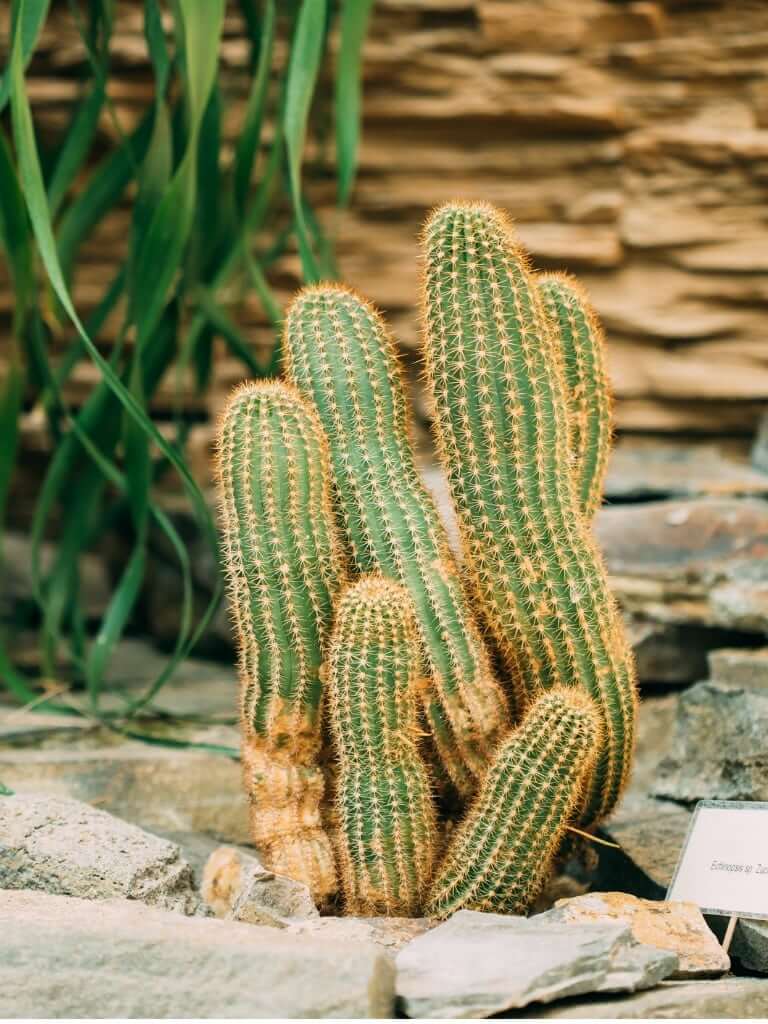
These types of cactus depend primarily on environmental circumstances. This cactus is just firm in zones 10 and 11, although it can be developed as a houseplant.
It builds outside in south Florida and Texas and dry, hot regions of California and Arizona. The warmth is close, as, in Arizona, you should give goobers a small screen.
In the more desirable area of this area, give it the whole day.
They have bestowed it to the sun as many as potential when planted inside.
It only requires winter watering if it is not being kept cool, at or below 40 degrees Fahrenheit (5 Celsius).
Give your cactus a well-balanced compost once a year at the origin of the increasing season.
Growing a peanut cactus is relatively easy if you have the best conditions. If you are developing it indoors, it gets a reasonable rest period to flower next season.
Rest suggests that it should be kept calm with minimum watering. It may seem to wipe out and sink a little, but this is common.
Outdoors Cactus That You Can Have in Your Backyard Are:
Strawberry Cactus
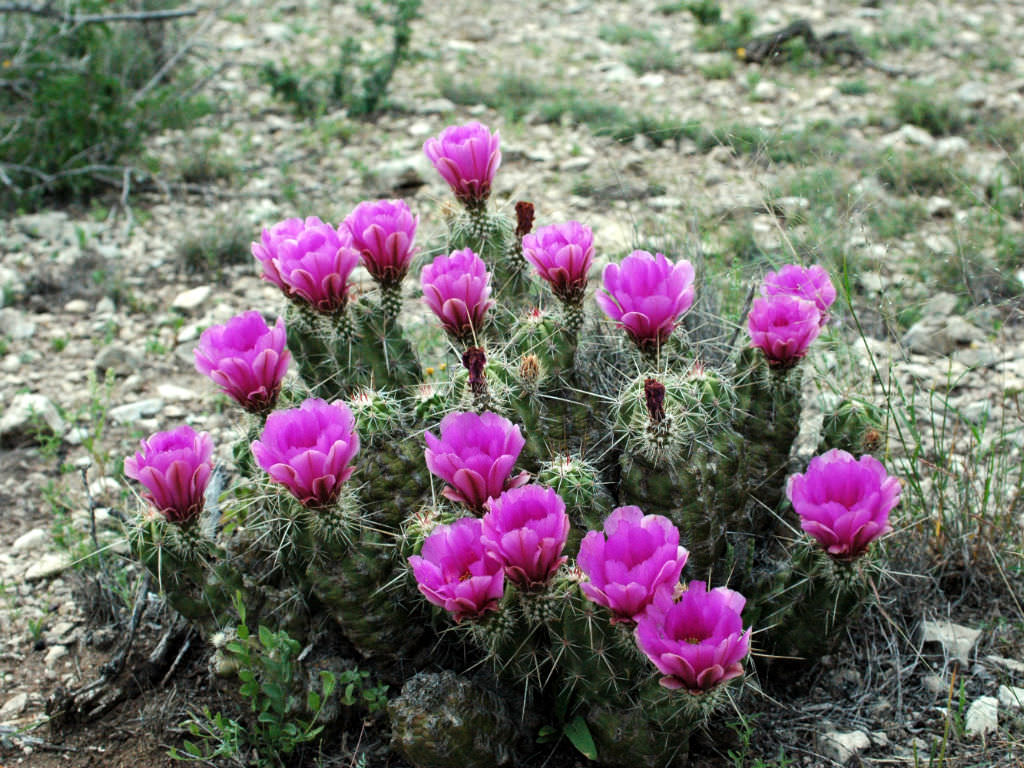
These kinds of cactus are some of the beautiful desert plants. Its name is derived from the strawberry-flavored fruit that it provides.
Its appearance has also earned numerous aliases, including a strawberry hedgehog, hedgehog cactus, porcupine hedgehog, straw-colored hedgehog, and pitaya.
‘Strawberry Cactus’ can be most pretty if your well-taken care of it. This cactus type needs average watering, just as the other succulents.
The watering process is fundamental to get your Strawberry Cactus healthy. It should not float on the water, do not excessively water the plant.
Make sure to dodge it. The smart way of watering is the soak and dry method. Yet, remember succulent should not overwater. Strawberry Cactus demands powerful light.
When planting these cactus types in a backyard or balcony, make assured they get sunlight. Full to partial sun is needed for their growth.
It is better to grow them outdoors rather than indoors. This succulent prefers a warmer climate.
It can survive at area 9a-11b, which is around -6.7 °C (20 °F). If you reside in a cold zone, it is sufficient to plant Strawberry Cactus in indoor surroundings.
The Queen of The Night
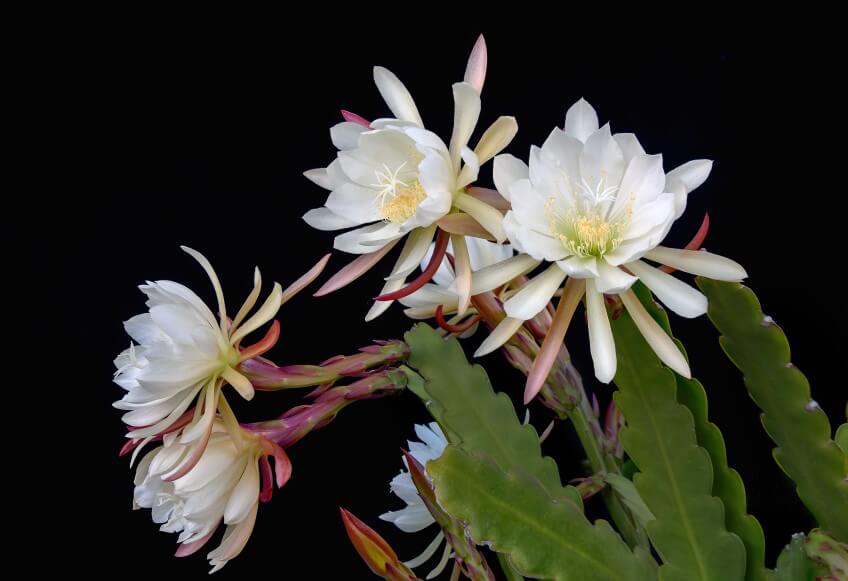
It would be best if you stayed up late to enjoy the opening of this great cactus, which is shaped like a striking waterlily. The queen of the night cactus blooms between evening and midnight – for us, she is the pinnacle of the party atmosphere.
White pleasantly scented circular-shaped flowers with pointed petals adorn this nightly flowering species.
These become drooping and drape, perfect for hanging pots. Flowers are large, white, and fragrant. They like the morning sun, light or filtered light, but dislike the hot afternoon sun, and their leaves will tend to yellow in this position.
About 2m, they grow as a slender shrub, making them useful for pots, courtyards, and under windows.
They enjoy the heat and quiet shade. They effortlessly and uncritically grow. In its natural surroundings, this epiphytic cactus hails from Mexico’s tropical rain forests, increases in the treetops, lives outside of other plants, glitches a ride up out of the dingy jungle brushwood.
Organ Pipe Cactus
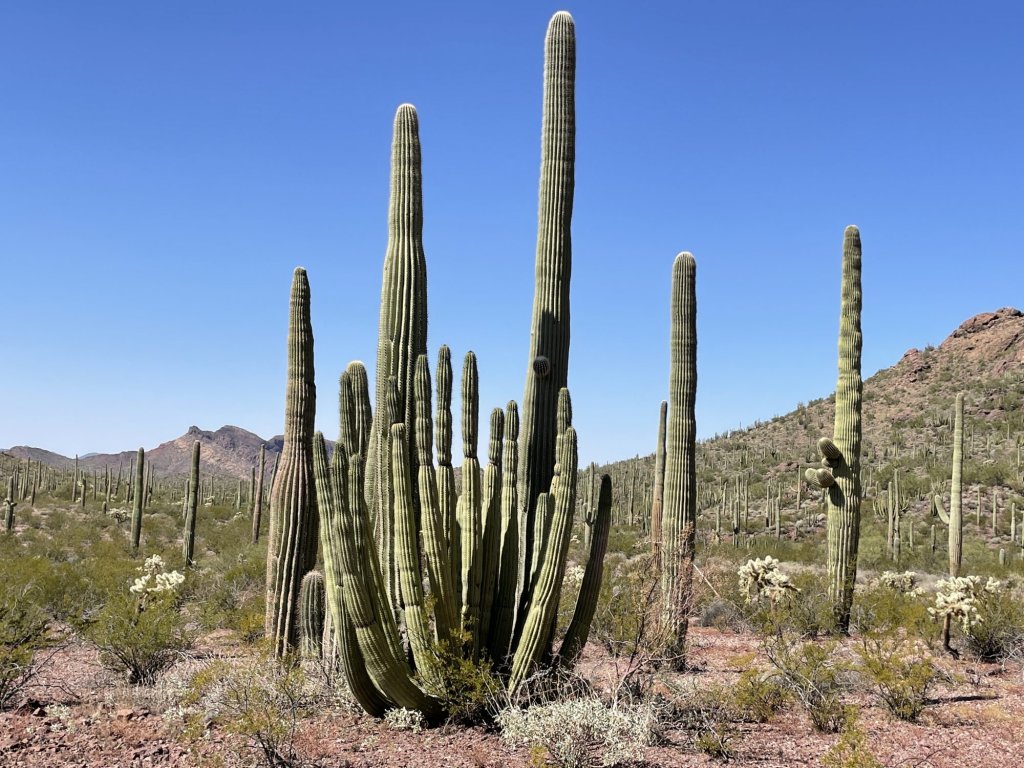
Organ pipe cactus is a wild-growing plant found in exotic, sunny southern Arizona. The cactus’ habitation is stony, sandy, and generally uninviting and infertile.
These cactus stems usually are about 16 feet (4.8 m.) high, and the whole plant can achieve 12 feet (3.6 m.) in width. The branches are ribbed with 12 to 19 inch (30 to 47.5 cm.) thick rims.
The entire plant is coated with black spines that become lighter as they get older.
The gland duct cactus lives for a longer time and does not reach maturity until it is 150 years old. This cactus care is achieved by watering them.
Claret Cup Cactus
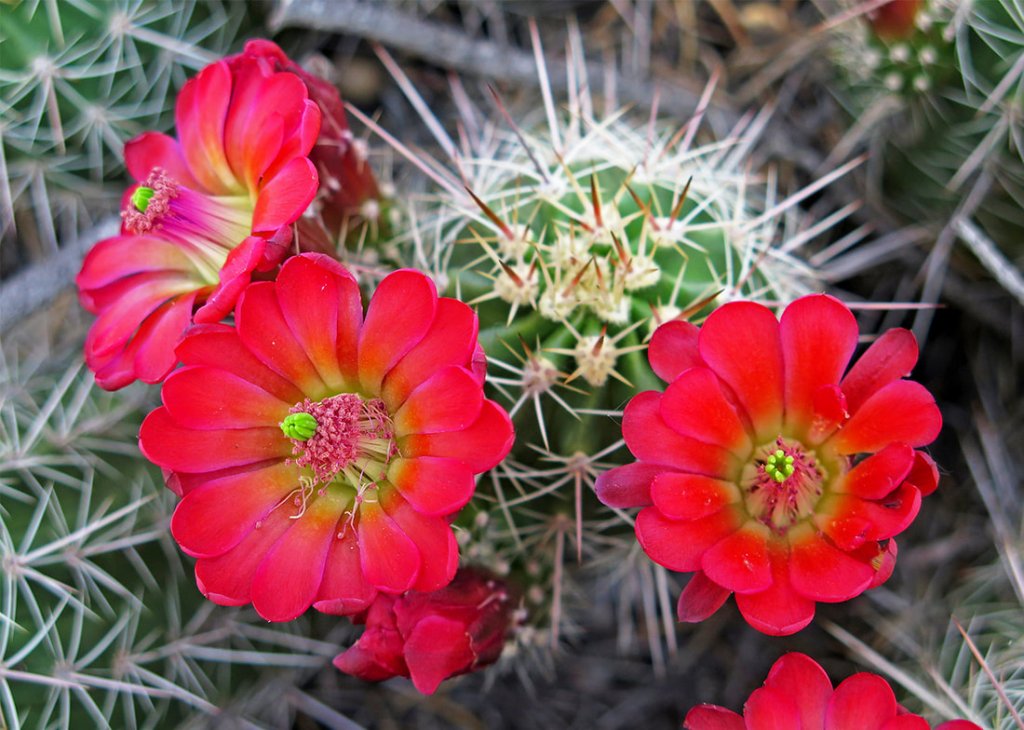
Claret cup cactus is domestic to the desert areas of the American Southwest. What is a claret cup cactus? It grows wild in Juniper Pinyon woods, creosote scrub, and Joshua forests.
The thin Variety and wonder of the desert landscape are riches even indoor gardeners cannot wait to experience.
Claret cup hedgehog cactus is the desert beauties that warm, arid climate gardeners can grow outside in their landscape.
Saguaro Cactus
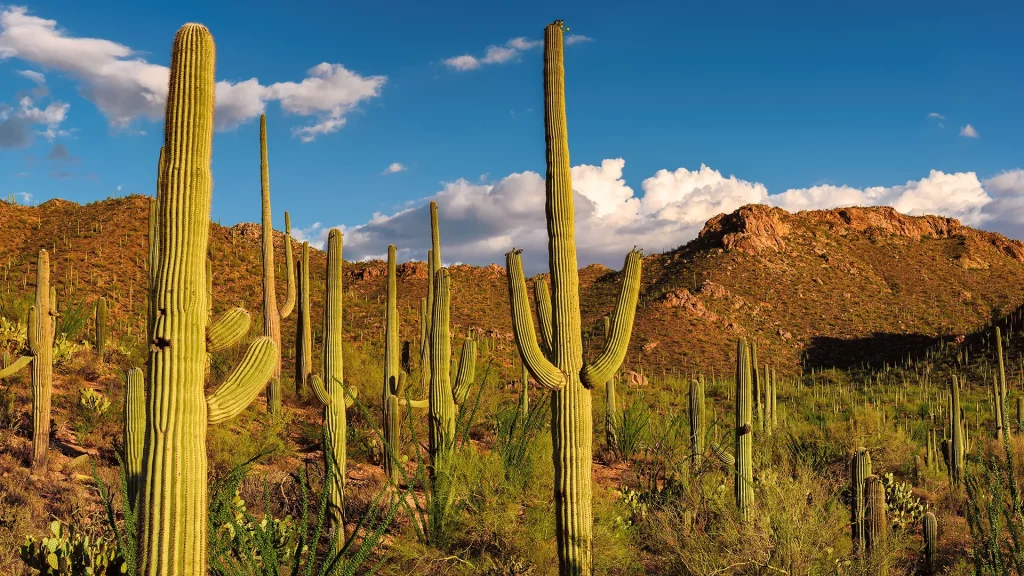
These types of cactus are very unusual-looking trees in the arid region. It has become the topic of many photographs and commonly craves up thoughts of the early west and the Southwest desert’s charm.
The saguaro flower is about a three-inch-wide group of smooth white petals around an opaque cluster of yellow stamens on a four-inch-stretched stem.
Saguaro is identified to have more stamens per flower than any different cactus flower on the earth.
The cactus is a very steady-growing plant, which may add only 1 to 1.5 inches (2.5-3 cm.) when it reaches the first eight years of life, then Saguaro grows arms or lateral stems, but it takes up to almost 75 years to produce the first one.
Saguaro is remarkably enduring, and many found in the desert are more than 175 years old.
Myritillocatus
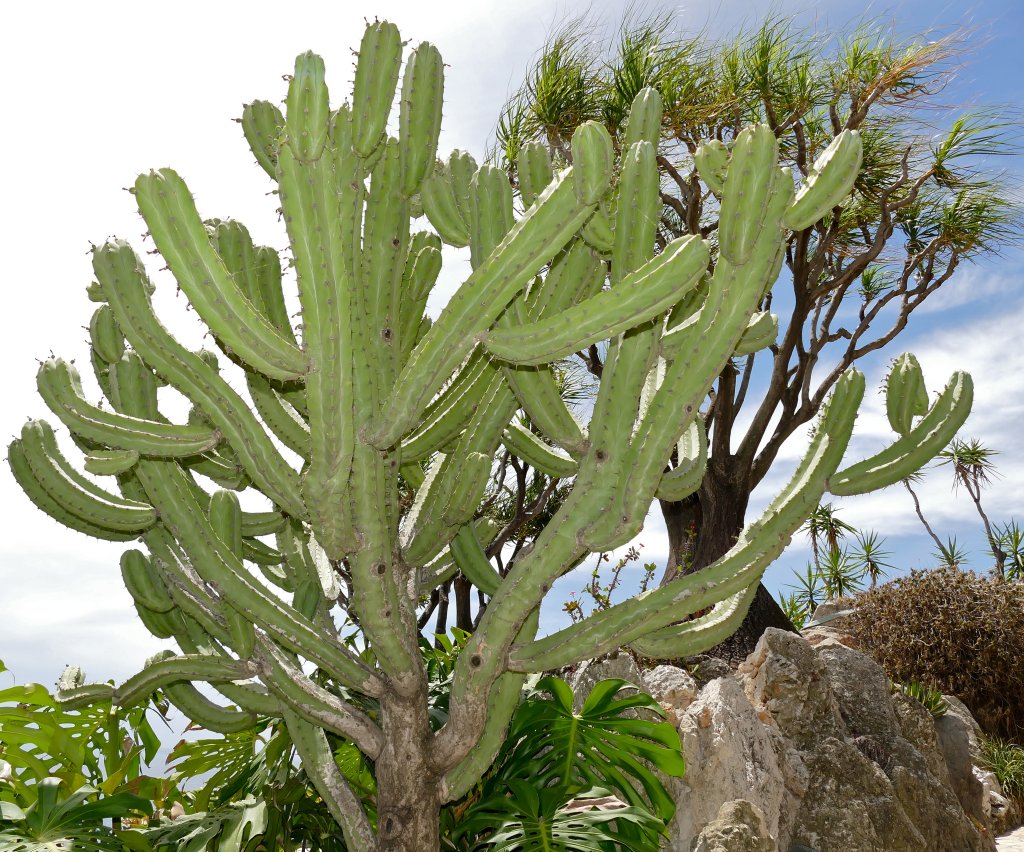
Myrtillocactus is a speedy-growing cylindrical succulent tree cactus that reaches 13 to 16 feet high and has 2″ to 4″ inch thick blue-green or blue-grey smaragdine stems with multiple areoles and 5 to 8 ribs. The plant remains branchless for a long time.
Yet, it produces various branches when it reaches maturity resembling candelabra.
Hence, the common name, blue candle. Like all other cacti and succulents, the blue Myrtillocactus demands proper sunlight to grow.
Prickly Pears
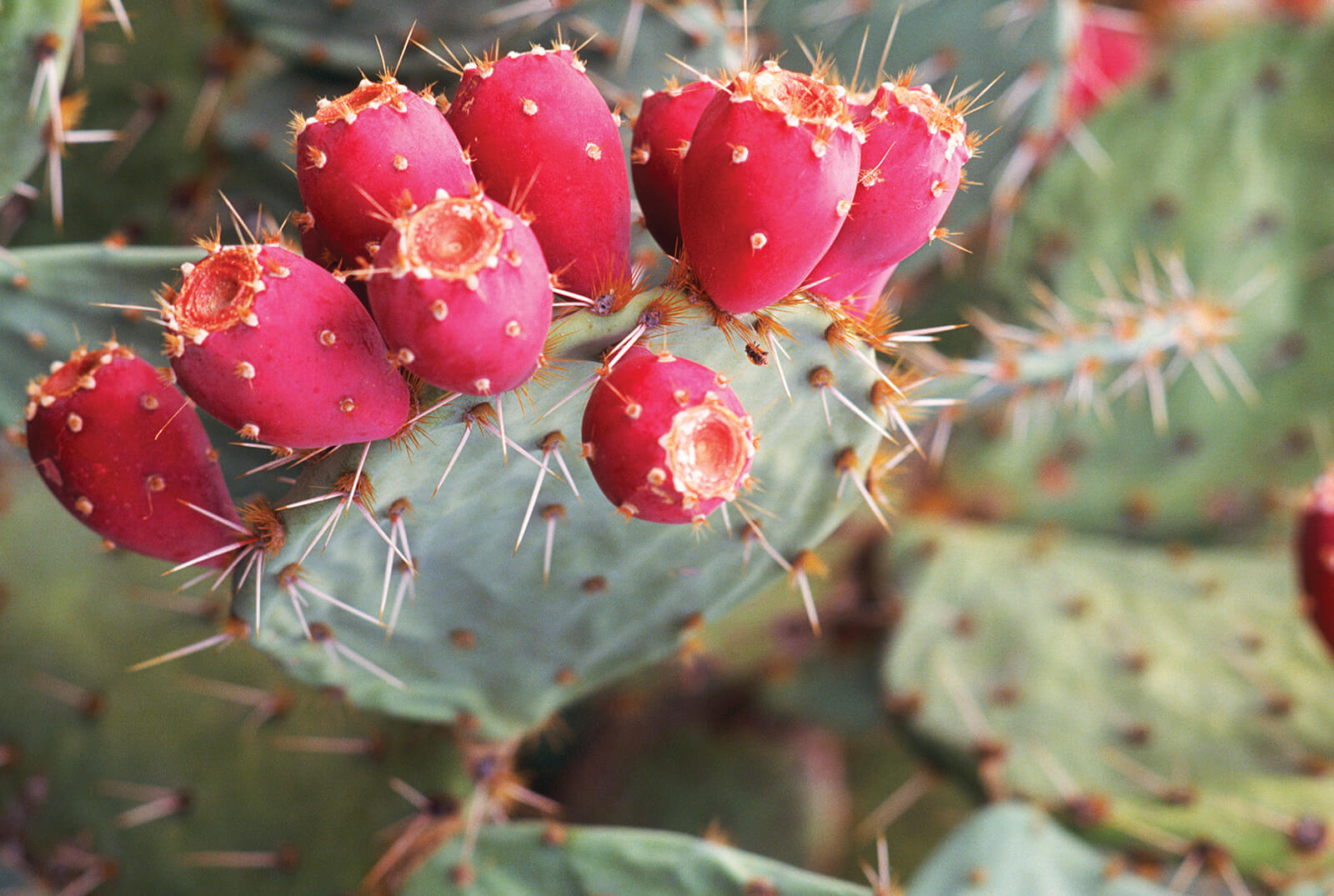
These cactus are part of the subgroup of Opuntia, known by their cover, flat, dividing pads, and are commonly known as nopal cactus or pole cactus.
Most of its variations have a mixture of detachable bones and groups of sharp bristles (glochids) that can create meaningful allergic skin responses.
Prickly pears need a location that accepts full sun by well-draining soil.
Transport at a similar level as they are currently evolving; comprehensive farming may cause them to deteriorate.
Control correctly, not just for your protection, but the pads can get overloaded and break off.
Additional help can be profitable because sharp pears can be bulky and uncomfortable raising and placing in the hole.
Conclusion
In conclusion, the world of cacti offers a diverse range of options for indoor plant enthusiasts.
Whether you are drawn to the unique shape of the Bunny Pear Cactus or the fascinating hair-like features of the Old Lady Cactus, there’s a cactus to suit every taste and interior decor.
This guide, complete with indoor cactus types with pictures, serves as a valuable resource for anyone looking to add these low-maintenance yet striking plants to their indoor spaces.
Each cactus type mentioned not only brings a distinct look to your home but also thrives with minimal care, proving that beauty and ease can indeed go hand in hand.

